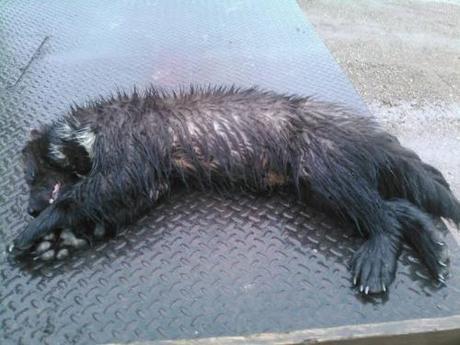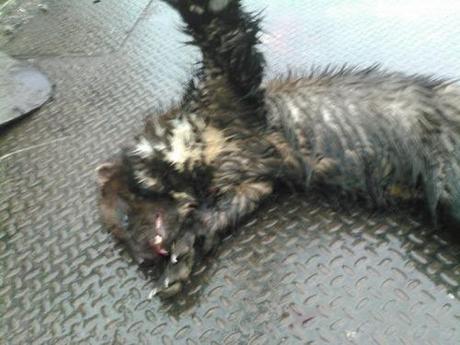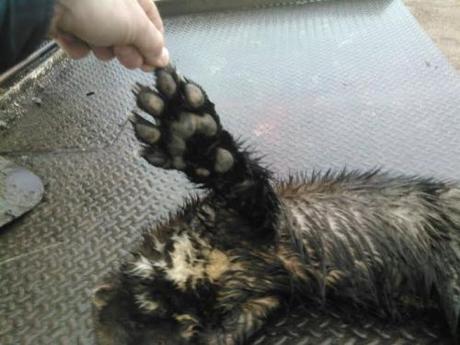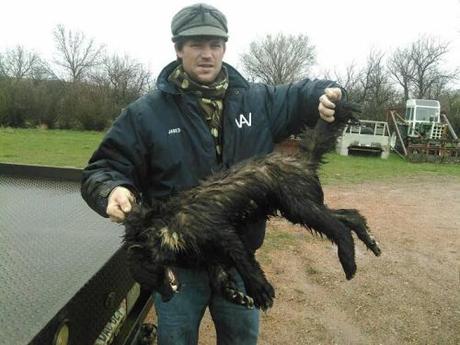A wolverine was apparently killed in Western North Dakota on Monday, April 25, 2016. The wolverine was killed near Alexander, North Dakota, probably during the daylight hours but at an unknown time. It is not known how the animal was killed, but no doubt it was shot dead with some sort of longarm weapon. The animal was killed by a rancher when it was harassing pairs of calves in a field. The rancher thought it was going to kill one of his calves, so he shot it.
After the rancher killed the animal, he contacted the North Dakota Game and Fish Department. Biologists from the department examined the animal and determined that it was indeed a wolverine. The kept the wolverine and took it away to an unknown location. Apparently there has not yet been any news reports of this incident. This report will be the first report of the incident and the photos associated with it to appear in the mainstream online media.
There have been a number of unverified sightings of wolverines in North Dakota in the past two decades. They are listed in my report, Wolverines in the Upper Midwest, available here. This is the most detailed report on wolverines in this region on the Internet or possibly anywhere for that matter. Be sure to check it out if you are interested in the subject. It has lots of great photos of the areas in which wolverines were spotted and the general terrain of the region.
It is an open question when the last verified wolverine was taken in North Dakota, as the US Fish and Wildlife Service apparently maintains that there has never been one good record of a wolverine from North Dakota. However, there are 36 known records of wolverines taken in North Dakota, but 35 of these, from a variety of locales in northeastern North Dakota, are from the journal of a single fur trapper from Montreal, Alexander Henry the Younger.
The USFWS regards these records as possibly spurious since they nearly all came from a single person, and it is uncertain whether these are records of locales where wolverines were actually taken or whether these were instead collection points for specimens from the fur trapping trade. Wolverine biologists feel that according to the known habitat associations of the wolverine in the US, it is not possible that North Dakota ever housed a population of established wolverines or that North Dakota was ever suitable wolverine habitat.
They also say that the entire area of the US Northeast, Great Lakes and Great Plains never had an established population of wolverines. However, biologists reported that two juvenile wolverines were taken in the Diamond Lakes area of New Hampshire in a single year, 1918. The biologists felt that the taking of two young in a single year meant that a breeding population of wolverines may have been present at that time. Therefore, the current theory that the Northeast never had an established population of wolverines may be incorrect.
The question here centers around the question of what one means by established population. To wildlife biologists, established population means breeding population, and these people argue that the upper great plains does not offer suitable habitat for breeding wolverines, apparently due to the lack of snow cover into the Late Spring.
Experts also argue that wolverines cannot live in this region because summer temperatures are too high. Nevertheless, the high number of records from North Dakota from 1800-1810 indicates that wolverines probably were able to live here year round despite high summer temperatures. In addition, a wolverine recently lived for 5-10 years around the area of Ubly, Michigan where summer temperatures may well be as high as those in North Dakota.
Based on this data, the Summer Temperature Theory about wolverines is wrong. After consulting with Dr. Keith Aubry, Dr. Aubry acknowledged that the truth is that wolverines can live in areas where the summer temperatures get up to 80-85, but they do not prefer to, and they probably do not live well or thrive in these places.
Based on the number of reports coming in of wolverines not only from North Dakota but also from elsewhere in the Upper Midwest and the long historical record of sightings in this area from the 19th Century, the Great Plains may possibly have been habitat pre-contact and even for a period of time after contact before they were extirpated by the fur trade. The reason that the prairie cannot be habitat now is because of the lack of deep snow persisting into Late Spring. It is true that in Alexander, North Dakota, deep snow does not persist into Late Spring therefore precluding breeding in the Great Plains.
Although the prairie seems to be an odd place to have wolverines, when you think about the great herds of buffalo that used to roam here, perhaps it is not so strange after all. Aubry agreed that the Great Plains would have been perfect habitat for wolverines at least due to the huge herds of buffalo that would have provided a ready source of large amounts of carrion that would be perfect for a scavenger like a wolverine.
He also said that it was much colder in the US in 1800 than it is today because that was during the tail end of a several centuries-long Little Ice Age where temperatures dropped all over North America. Since then, the continent has been warming up and what may have been cold enough for wolverines in 1800 is no longer suitable habitat now that it is much warmer.
Aubry also noted that Canadian scientists feel that there has been a retraction of the wolverine’s range in Ontario over the past century or so. Whereas once wolverines occurred throughout the province from north to south, they have retreated north and are now found only in the northern half of Ontario.
My post on wolverines in the Upper Midwest has a number of photos of prairie terrain and habitat along with some theorizing on how and why the prairies may have been good habitat for wolverines pre-contact.
Wolverines were last taken in Indiana in 1852, Michigan in 1860, Wisconsin in 1870, and Minnesota in 1899. Another wolverine was killed recently in Minnesota in 1965.
Alexander Henry’s journals date from 1799-1808 when he worked as a fur trapper for the Montreal-based North West Company. During this period, Northeastern North Dakota had not yet been settled by Whites, so his records would seem to be a good record of the wildlife presence and density in this region pre-contact. At this time, the land was the territory of Dakotas, but Chippewas and Crees were also in the area.
He lived for most of the time at a fort at the mouth of the Penimba River. In those nine years, Henry reports that 35 wolverines were trapped in northeastern North Dakota alone. Based on the evidence, the last records of wolverines in North Dakota may be from 1808 or earlier. Therefore, this may be the first wolverine record in North Dakota in 208 years.
Photos of the wolverine are available below. Based on the photographs, I believe that is a wolverine. In addition, three of the top wolverines experts in the country, Aubry, Dr. Reginald Barrett, and Dr. Rebecca Watters of the Wolverine Foundation, all confirmed to me that these are photos of an actual wolverine.

Side view of the wolverine killed just recently in North Dakota. Note the huge padded paws and the massive claws.

Another side view with an emphasis on the head and front of the animal. Note the black and white dual colored hair color, the shape of the small ears, the elongated snout, the big fangs and of course the huge padded paws. The pads and claws on the feet of a badger look something like this, but on the wolverine, these characteristics may be more accentuated.

Yet another photo of the wolverine, this time with an emphasis on the paws and the claws.

Wolverine shot in North Dakota on April 25. The man holding the animal is possibly the one who shot and killed the animal.
References
- Aubry, Keith. April 28, 2016. Research Wildlife Biologist. Ecological Process and Function Division, Research and Development Department, Pacific Northwest Research Station. United States Forest Service. Olympia, Washington. Personal communication.
Aubry, K. B., K. S. McKelvey, and J. P. Copeland. 2007. Geographic Distribution and Broadscale Habitat Relations of the Wolverine in the Contiguous United States. Journal of Wildlife Management 71: 2147-2158.
Copeland, J. P. and Whitman, J. S. 2003. “Wolverine,” pp. 672-682, in Wild Mammals of North America, Biology, Management, and Economics. G. A. Feldhamer, B. C. Thompson, and J. A. Chapman, eds. Johns Hopkins University Press.
Henry, Alexander. 1988. The Journal of Alexander Henry The Younger 1799-1814. Toronto: The Champlain Society, University of Toronto Press.
Jackson, C. F. August 22, 1922. Notes on New Hampshire Mammals. Journal of Mammalogy 3:1, p. 13.
Whitaker, John O. and Hamilton, William John. 1998. Mammals of the Eastern United States, p. 551. Ithaca, NY: Cornell University Press.
